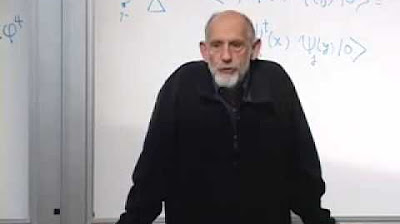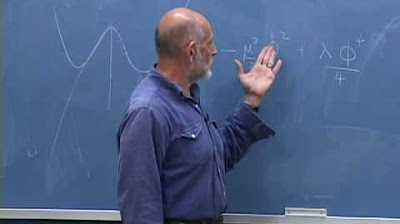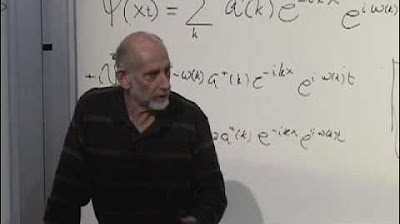Supersymmetry & Grand Unification: Lecture 1
TLDRThe provided transcript is a detailed lecture on the concept of renormalization in quantum field theory, delivered at Stanford University. The speaker delves into the intricacies of renormalization, explaining its importance in eliminating irrelevant small-scale distances and high-frequency phenomena from physical descriptions. The lecture explores the process of renormalization through the use of dimensional analysis and Feynman diagrams, highlighting how it simplifies calculations by replacing complex interactions with effective parameters. The discussion also touches on the fine-tuning problems associated with the Higgs boson mass and vacuum energy, emphasizing the challenges in particle physics and the potential role of supersymmetry in addressing these issues. The summary underscores the lecturer's aim to provide a deeper understanding of quantum field theory and its applications in modern physics.
Takeaways
- 📚 The concept of renormalization in quantum field theory involves eliminating irrelevant small-distance details and replacing them with effective parameters that are useful for the scale of interest.
- 🚀 Renormalization is used to address the hierarchy problem between different scales in physics, such as the vast difference between the Planck scale and the electroweak scale.
- ⚖️ Fermions and gauge bosons in the standard model do not undergo mass renormalization to the same extent as scalar particles, which is why the Higgs mechanism is crucial for giving mass to other particles.
- 🔍 The fine-tuning problem arises because the Higgs boson mass receives enormous corrections from quantum fluctuations, which must cancel out to an extraordinary degree to result in the observed mass.
- 🧬 Supersymmetry is proposed as a solution to the Higgs fine-tuning problem by matching fermions and bosons in such a way that their contributions to the vacuum energy cancel each other out.
- ⚛️ The vacuum energy of the universe, or cosmological constant, is another fine-tuning problem that requires an extremely precise cancellation of energies to avoid causing rapid expansion or contraction of the universe.
- 🤔 The standard model of particle physics works well down to very small distance scales, but it requires an explanation for the mass contributions and renormalization effects from scales between the experimental scale and the smallest scale where the theory is believed to hold.
- 🌌 The cosmological constant problem is related to the vacuum energy and its contribution to the gravitational field, which becomes significant when considering the large-scale structure of the universe.
- 📉 In quantum field theory, the vacuum energy is renormalized by diagrams with no input and output particles, which can lead to a non-zero vacuum energy that may have implications for gravity and dark energy.
- 🤓 Scalar particles, like the Higgs boson, are characterized by having zero spin and do not change when coordinates are rotated, unlike vector or tensor particles which do transform under such operations.
- 🔧 The renormalization process involves summing up all the effects of very small distances and high frequencies, encapsulating them into an effective description that allows for manageable calculations in particle physics.
Q & A
What is renormalization in quantum field theory?
-Renormalization is a process in quantum field theory that involves eliminating details about physics at distances so small that they are irrelevant to the questions being asked. It combines learning how to disregard irrelevant small distances with dimensional analysis to simplify calculations involving quantum field theory.
Why is the concept of renormalization important in physics?
-Renormalization is crucial because it allows physicists to handle calculations involving quantum field theory by focusing on relevant scales while disregarding the effects of very small, high-energy scales that are not of interest. This simplifies the problem and makes it more manageable.
How does renormalization relate to the standard model of particle physics?
-Renormalization is essential in the standard model as it helps in dealing with infinities that arise in calculations. It provides a framework to make precise predictions by redefining parameters in the theory to account for effects at different scales.
What is the role of dimensional analysis in renormalization?
-Dimensional analysis plays a key role in renormalization by helping to determine the form and scaling of physical quantities in a theory. It assists in understanding how different terms in an equation scale with respect to mass, length, and time, which is vital for simplifying complex quantum interactions.
Can you explain the concept of a cutoff in the context of renormalization?
-A cutoff in renormalization is an artificial boundary that separates the scales of physics that are relevant to a particular problem from those that are not. It is used to ignore the contributions from very high energies or very short distances that are not of interest, thus simplifying calculations.
What is the fine-tuning problem associated with the Higgs boson?
-The fine-tuning problem of the Higgs boson arises because the Higgs mass term receives large quantum corrections that could drive its value to extremely high energies, much higher than observed. To avoid this, an enormous fine-tuning of parameters is required to cancel out these corrections and maintain the observed mass of the Higgs boson.
How does supersymmetry attempt to solve the fine-tuning problem?
-Supersymmetry is a proposed symmetry that relates fermions and bosons. It introduces a partner particle for every known particle, and these partners have opposite spin statistics. The idea is that the large quantum corrections to the Higgs mass from bosons could be canceled out by corresponding corrections from their fermionic superpartners, thus solving the fine-tuning problem.
What is the cosmological constant problem, and how is it related to fine-tuning?
-The cosmological constant problem is the discrepancy between the observed value of the vacuum energy density (or dark energy) and the theoretically predicted value, which is many orders of magnitude larger. This problem requires an extreme fine-tuning of the vacuum energy to match the observed cosmological constant, and it is one of the major unsolved problems in physics.
Why are fermions considered to be better behaved than scalar particles in terms of renormalization?
-Fermions are considered better behaved because they do not receive large quantum corrections to their mass in certain theories, such as quantum electrodynamics. If a fermion starts massless, it remains massless, as gauge boson emissions and absorptions do not flip helicity. This means that fermions do not exhibit the same level of fine-tuning problems as scalar particles like the Higgs boson.
What is the significance of the vacuum energy in the context of gravity?
-In the context of gravity, the vacuum energy becomes significant because it contributes to the energy-momentum tensor, which sources the gravitational field according to Einstein's general theory of relativity. A non-zero vacuum energy implies that even empty space can gravitate, which has implications for the understanding of dark energy and the accelerated expansion of the universe.
How does the concept of renormalization apply to the understanding of atomic and nuclear physics?
-Renormalization allows physicists to focus on the relevant scales when studying atomic and nuclear physics. For instance, when considering the nucleus, one can often ignore the details of the quark-gluon structure and instead focus on protons and neutrons. Similarly, when studying atoms, the details of the nucleus can be encapsulated in a few key parameters like mass and charge, allowing for a more manageable description of atomic properties.
Outlines
😀 Introduction to Renormalization
The paragraph introduces the concept of renormalization in quantum field theory. It explains that renormalization involves eliminating irrelevant small distances and applying dimensional analysis to solve complex problems in quantum field theory. The speaker uses the analogy of a nucleus being made of quarks but for many purposes, it's more useful to consider it as a collection of protons and neutrons. The paragraph also touches on the idea of solving quantum chromodynamics to compute the properties of protons and neutrons.
🔍 Renormalization and Atomic Physics
This paragraph delves into the application of renormalization in atomic physics. It discusses how atomic properties can be calculated using nuclear physics and that the mass and charge of the nucleus are key to atomic physics. The speaker emphasizes that once these properties are known, the details of protons and neutrons can be disregarded. The paragraph also illustrates the process of renormalization by comparing it to moving from a description of atoms to a more coarse-grained description that is more useful for certain purposes.
🧮 Quantum Mechanical Problem and Hamiltonian
The speaker outlines the quantum mechanical approach to the problem at hand, starting with the Hamiltonian, which represents the energy of the system. The paragraph discusses the non-relativistic quantum mechanics and the kinetic energy of the nuclei. It also covers the Coulomb force between the nuclei and the electrons' kinetic energy. The speaker then moves on to discuss the forces between the electrons and the force between the protons and electrons, emphasizing the slow movement of the nuclei compared to the electrons.
🤔 Solving the Schrodinger Equation
The focus of this paragraph is on solving the Schrodinger equation to find the ground state energy of the electrons in a fixed background of nuclei. The speaker describes the process of fixing the positions of the nuclei and solving for the lowest energy state, which allows for the elimination of the electrons from the problem. The resulting Hamiltonian is then a function of the positions of the nuclei only, leading to an effective potential energy that includes the influence of the electrons.
📐 Dimensional Analysis in Quantum Field Theory
The paragraph provides a break from renormalization theory to focus on dimensional analysis in physics. It emphasizes the importance of specifying one dimension in particle physics, which can be mass, energy, momentum, length, or time. The speaker also discusses how mass and energy are equivalent in units due to the famous equation E=mc^2, and how setting h-bar and c equal to one simplifies the problem, leaving only one dimensional quantity to specify.
🌐 Scalar Quantum Field Theory and Fineman Diagrams
This paragraph introduces a scalar quantum field theory with a single scalar field Phi, and discusses the Lagrangian from which Fineman diagrams are derived. The speaker explains the components of the Lagrangian, including the kinetic term and potential energy. The paragraph also covers the concept of action in quantum field theory and the importance of the Lagrangian density, which must have inverse length to the fourth power.
🔗 Renormalization and Dimensionless Coupling Constants
The focus is on the significance of dimensionless coupling constants in renormalization theory. The speaker discusses the units of various terms in the Lagrangian and how they relate to mass and energy. The paragraph also explains the structure of Fineman diagrams, which are built from vertices and propagators, and how these contribute to the amplitude of a process in quantum field theory.
🚀 Renormalization of Mass in Scalar Field Theory
The paragraph explores the renormalization of mass within scalar field theory. It explains that the mass term in the Lagrangian can be affected by quantum fluctuations, leading to a need for renormalization. The speaker uses the concept of a cutoff scale to ignore small-scale physics and shows how the original mass term can be combined with quantum corrections to form an effective mass term, which is measurable in experiments.
🔢 Infinite Series and Renormalization
This paragraph discusses the appearance of an infinite series of terms in the process of renormalization, each contributing to the mass correction with powers of the coupling constant over the cutoff scale. The speaker explains that while higher-order diagrams may contribute less, they still must be considered in the renormalization process. The paragraph also touches on the concept of dimensional analysis in evaluating these contributions.
🎚 Renormalization of Lambda and Fine-Tuning
The speaker addresses the renormalization of the coupling constant lambda and the concept of fine-tuning. It is explained that every term in the Lagrangian can be renormalized, and the effective parameters measured in experiments account for all the short-distance physics. The paragraph also highlights the fine-tuning problem associated with the Higgs boson mass and the hierarchy problem in particle physics.
🤓 Fermions and Gauge Bosons Renormalization
The paragraph contrasts the behavior of fermions and gauge bosons with scalar particles in terms of renormalization. It is shown that fermions and gauge bosons, if initially massless, remain massless even after renormalization. The speaker explains that the fine-tuning problem is primarily associated with the Higgs boson and that supersymmetry might offer a potential solution to this problem.
📉 Vacuum Energy and Fine-Tuning
The final paragraph discusses the vacuum energy and its role in the fine-tuning problem. It is explained that while vacuum energy is not significant in most physics, it becomes important when considering gravity, as it contributes to the gravitational field. The speaker highlights the need for fine-tuning the vacuum energy to an extremely high precision and mentions the cosmological constant problem, which is related to dark energy.
Mindmap
Keywords
💡Renormalization
💡Quantum Field Theory
💡Dimensional Analysis
💡
💡Scalar Field
💡Fermions
💡Gauge Bosons
💡Higgs Boson
💡Fine-Tuning Problem
💡Supersymmetry
💡Vacuum Energy
Highlights
Renormalization is a method to eliminate irrelevant small distances in physics problems and is a combination of dimensional analysis.
The concept of renormalization is essential in quantum field theory, particularly when dealing with quantum chromodynamics and the properties of protons and neutrons.
In atomic physics, the mass and charge of the nucleus are of primary interest, allowing for the simplification of models by disregarding the underlying quark structure.
The process of renormalization involves summing up the effects of very small distances and replacing them with effective parameters in the description of physics problems.
Dimensional analysis plays a crucial role in quantum field theory, helping to determine the dimensions of various terms in the Lagrangian and Feynman diagrams.
The Lagrangian for a scalar quantum field theory is introduced, emphasizing the importance of the kinetic term and potential energy.
Feynman diagrams are constructed from vertices and propagators, which are integral to calculating the amplitude for a process to occur in quantum field theory.
The concept of a cutoff is introduced as a means to ignore length scales smaller than a certain value, simplifying calculations in quantum field theory.
The renormalization of mass in scalar field theory is explained, showing how the effective mass incorporates contributions from high-frequency fluctuations.
The issue of fine-tuning in the Higgs boson mass is discussed, highlighting the challenge of why the observed mass is much smaller than the natural scale of quantum gravity.
Fermions, unlike scalar particles, do not undergo mass renormalization when they are massless, which is a significant difference in their behavior.
Gauge bosons, if initially massless, remain massless under renormalization group transformations, which is a key property in understanding the mass scales of the standard model.
The fine-tuning problem of the Higgs boson is a major puzzle in particle physics, which supersymmetry and other theories attempt to address.
The vacuum energy is also subject to renormalization, leading to a cosmological constant problem that requires an enormous degree of fine-tuning.
Supersymmetry is presented as a potential solution to the fine-tuning problem of the Higgs boson, though it does not address the cosmological constant issue.
The importance of understanding the contributions from different scales in quantum field theory is emphasized, as it is crucial for the consistency of the standard model.
Scalar particles are defined as having no spin or angular momentum, contrasting with vector and tensor particles like photons and gravitational fields.
Transcripts
Browse More Related Video
5.0 / 5 (0 votes)
Thanks for rating:





